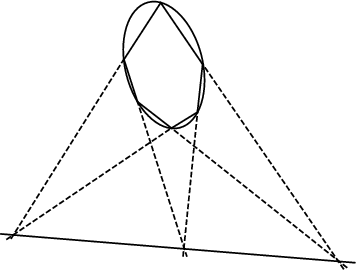|
|
|

The dual of Brianchon's Theorem. It states that, given a (not necessarily Regular, or
even Convex) Hexagon inscribed in a Conic Section, the three pairs of the
continuations of opposite sides meet on a straight Line, called the Pascal Line. There are 6! (6! means 6
Factorial, where
![]() ) possible ways of taking all Vertices in any order, but among these are six equivalent Cyclic Permutations and two
possible orderings, so the total number of different hexagons (not all simple) is
) possible ways of taking all Vertices in any order, but among these are six equivalent Cyclic Permutations and two
possible orderings, so the total number of different hexagons (not all simple) is
See also Braikenridge-Maclaurin Construction, Brianchon's Theorem, Cayley-Bacharach Theorem, Conic Section, Duality Principle, Hexagon, Pappus's Hexagon Theorem, Pascal Line, Steiner Points
References
Coxeter, H. S. M. and Greitzer, S. L. Geometry Revisited. Washington, DC: Math. Assoc. Amer., pp. 73-76, 1967.
Ogilvy, C. S. Excursions in Geometry. New York: Dover, pp. 105-106, 1990.
Pappas, T. ``The Mystic Hexagram.'' The Joy of Mathematics.
San Carlos, CA: Wide World Publ./Tetra, p. 118, 1989.